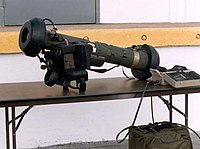
Photo from wikipedia
To date, explosive synchronization (ES) in a network is shown to be originated from considering either degree-frequency correlation, frequency-coupling strength correlation, inertia, or adaptively controlled phase oscillators. Here we show… Click to show full abstract
To date, explosive synchronization (ES) in a network is shown to be originated from considering either degree-frequency correlation, frequency-coupling strength correlation, inertia, or adaptively controlled phase oscillators. Here we show that ES is a generic phenomenon and can occur in any network by multiplexing it with an appropriate layer without even considering any prerequisite for the emergence of ES. We devise a technique which leads to the occurrence of ES with hysteresis loop in a network upon its multiplexing with a negatively coupled (or inhibitory) layer. The impact of various structural properties of positively coupled (or excitatory) and inhibitory layers along with the strength of multiplexing in gaining control over the induced ES transition is discussed. Analytical prediction for the spread of phase distribution of each layer is provided, which is in good agreement with the numerical assessment. This investigation is a step forward in highlighting the importance of multiplex framework not only in bringing phenomena which are not possible in an isolated network but also in providing more structural control over the induced phenomena.
Journal Title: Physical review. E
Year Published: 2019
Link to full text (if available)
Share on Social Media: Sign Up to like & get
recommendations!